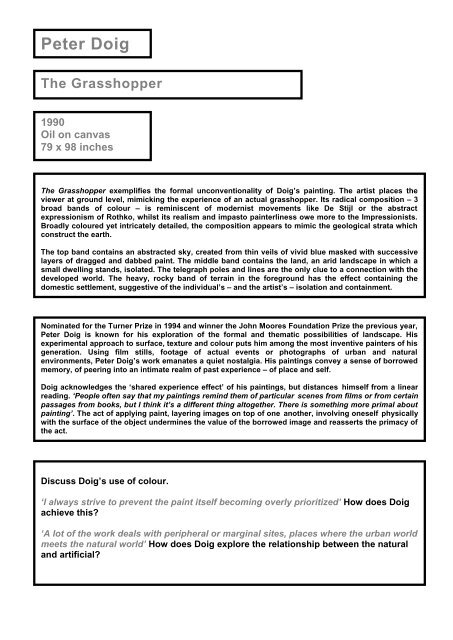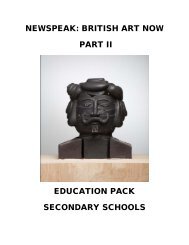THE TRIUMPH OF PAINTING SAATCHI GALLERY EDUCATION ...
THE TRIUMPH OF PAINTING SAATCHI GALLERY EDUCATION ...
THE TRIUMPH OF PAINTING SAATCHI GALLERY EDUCATION ...
You also want an ePaper? Increase the reach of your titles
YUMPU automatically turns print PDFs into web optimized ePapers that Google loves.
Peter Doig<br />
The Grasshopper<br />
1990<br />
Oil on canvas<br />
79 x 98 inches<br />
The Grasshopper exemplifies the formal unconventionality of Doig’s painting. The artist places the<br />
viewer at ground level, mimicking the experience of an actual grasshopper. Its radical composition – 3<br />
broad bands of colour – is reminiscent of modernist movements like De Stijl or the abstract<br />
expressionism of Rothko, whilst its realism and impasto painterliness owe more to the Impressionists.<br />
Broadly coloured yet intricately detailed, the composition appears to mimic the geological strata which<br />
construct the earth.<br />
The top band contains an abstracted sky, created from thin veils of vivid blue masked with successive<br />
layers of dragged and dabbed paint. The middle band contains the land, an arid landscape in which a<br />
small dwelling stands, isolated. The telegraph poles and lines are the only clue to a connection with the<br />
developed world. The heavy, rocky band of terrain in the foreground has the effect containing the<br />
domestic settlement, suggestive of the individual’s – and the artist’s – isolation and containment.<br />
Nominated for the Turner Prize in 1994 and winner the John Moores Foundation Prize the previous year,<br />
Peter Doig is known for his exploration of the formal and thematic possibilities of landscape. His<br />
experimental approach to surface, texture and colour puts him among the most inventive painters of his<br />
generation. Using film stills, footage of actual events or photographs of urban and natural<br />
environments, Peter Doig’s work emanates a quiet nostalgia. His paintings convey a sense of borrowed<br />
memory, of peering into an intimate realm of past experience – of place and self.<br />
Doig acknowledges the ‘shared experience effect’ of his paintings, but distances himself from a linear<br />
reading. ‘People often say that my paintings remind them of particular scenes from films or from certain<br />
passages from books, but I think it’s a different thing altogether. There is something more primal about<br />
painting’. The act of applying paint, layering images on top of one another, involving oneself physically<br />
with the surface of the object undermines the value of the borrowed image and reasserts the primacy of<br />
the act.<br />
Discuss Doig’s use of colour.<br />
‘I always strive to prevent the paint itself becoming overly prioritized’ How does Doig<br />
achieve this?<br />
‘A lot of the work deals with peripheral or marginal sites, places where the urban world<br />
meets the natural world’ How does Doig explore the relationship between the natural<br />
and artificial?




